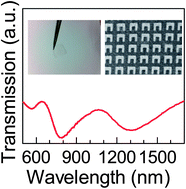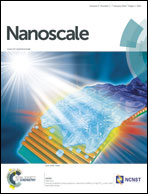Transparent free-standing metamaterials and their applications in surface-enhanced Raman scattering
Abstract
Integration of metamaterials onto a flexible substrate can provide many advantages such as transparency, deformability, light weight and biocompatibility. Here we demonstrate a simple and convenient nickel sacrificial layer-assisted transfer method to fabricate visible–near infrared (IR) metamaterials embedded into a thin polydimethylsiloxane (PDMS) film. Both the structures and the optical properties are maintained after transferring into the PDMS film from a rigid substrate. This PDMS-based metamaterial can behave as a high performance surface enhanced Raman scattering (SERS) device with tunable plasmonic bands, which decouple the preparation of SERS structure and the linkage of targeted molecules to the plasmonic structures. By simply covering the PDMS metamaterials device on the surface with molecules of interest, we demonstrate the application of 2-naphthalenethiol molecules self-assembled on a Au film, highlighting the considerable potential of these PDMS metamaterials as a SERS stamp onto any other substrate. What's more, the PDMS-based nanostructures offer a representative model to investigate the interaction between the plasmonic nanostructure and the substrate consisting of different materials by placing PDMS on the surface of the substrate.


 Please wait while we load your content...
Please wait while we load your content...